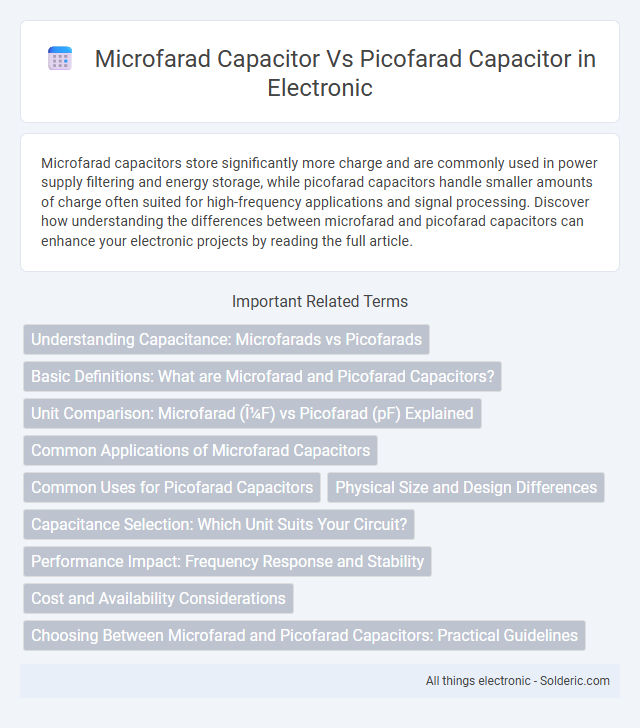Microfarad capacitors store significantly more charge and are commonly used in power supply filtering and energy storage, while picofarad capacitors handle smaller amounts of charge often suited for high-frequency applications and signal processing. Discover how understanding the differences between microfarad and picofarad capacitors can enhance your electronic projects by reading the full article.
Comparison Table
| Feature | Microfarad Capacitor (uF) | Picofarad Capacitor (pF) |
|---|---|---|
| Capacitance Value | 1 uF = 10-6 Farads | 1 pF = 10-12 Farads |
| Typical Usage | Power supply filtering, audio circuits, timing | High-frequency tuning, RF circuits, small signal filtering |
| Size | Larger physical size due to higher capacitance | Much smaller, suitable for high-frequency circuits |
| Voltage Range | Usually 10V to 450V | Typically 50V to 1000V, depending on type |
| Dielectric Types | Electrolytic, ceramic, film | Ceramic, mica, film |
| Applications | Decoupling, energy storage, timing circuits | Tuning circuits, RF filters, oscillator circuits |
| Cost | Generally inexpensive | Varies; precision types are costly |
Understanding Capacitance: Microfarads vs Picofarads
Microfarad capacitors store much larger amounts of electric charge compared to picofarad capacitors, with 1 microfarad equaling 1,000,000 picofarads. Microfarads are typically used in applications requiring significant energy storage or filtering, such as power supply circuits, while picofarads are ideal for high-frequency tuning and signal coupling in radio frequency circuits. Understanding the scale difference in capacitance values is crucial for selecting the correct capacitor to match the desired electrical characteristics of a circuit.
Basic Definitions: What are Microfarad and Picofarad Capacitors?
Microfarad capacitors store electrical charge measured in microfarads (uF), commonly used for filtering and energy storage in circuits requiring higher capacitance. Picofarad capacitors have capacitance values in picofarads (pF), ideal for high-frequency applications such as tuning circuits and signal processing where small capacitance is crucial. The significant difference in capacitance scales makes microfarads suited for bulk storage, while picofarads are essential for precision and speed in electronic components.
Unit Comparison: Microfarad (μF) vs Picofarad (pF) Explained
The microfarad (mF) is one million times larger than the picofarad (pF), where 1 mF equals 1,000,000 pF, making mF capacitors suitable for applications requiring higher capacitance such as power supply filters. Picofarad capacitors, on the other hand, are typically used in high-frequency circuits and precision tuning due to their extremely small capacitance values. Understanding the scale difference between these units is crucial for selecting the appropriate capacitor in electronic circuit design.
Common Applications of Microfarad Capacitors
Microfarad capacitors are commonly used in power supply filtering, audio equipment, and motor start applications due to their higher capacitance values which store larger amounts of charge. Their capacity, typically ranging from 1 uF to several thousand uF, makes them ideal for smoothing voltage fluctuations and energy storage in circuits. Your electronic projects benefit from microfarad capacitors when stable and efficient power delivery is essential.
Common Uses for Picofarad Capacitors
Picofarad capacitors are primarily used in high-frequency applications such as radio frequency (RF) circuits, oscillators, and tuning circuits due to their small capacitance values that allow precise control of signal filtering and timing. These capacitors excel in coupling and decoupling high-frequency signals and are essential in circuits that require minimal parasitic capacitance. In contrast, microfarad capacitors are more common in power supply filtering and energy storage where larger capacitance is required.
Physical Size and Design Differences
Microfarad capacitors typically have larger physical sizes due to their higher capacitance values, requiring thicker dielectric materials and more extensive internal electrode surfaces, whereas picofarad capacitors are much smaller with finer design elements to achieve low capacitance in compact form factors. Design differences include the use of ceramic or film dielectrics in picofarad capacitors for high-frequency applications, while microfarad capacitors often utilize electrolytic or tantalum materials to maximize capacitance density. These distinctions result in microfarad capacitors suited for power filtering and energy storage, contrasting with picofarad capacitors used primarily in RF tuning and signal processing circuits.
Capacitance Selection: Which Unit Suits Your Circuit?
Microfarad capacitors store much higher charge compared to picofarad capacitors, making them ideal for applications requiring larger energy storage or smoother voltage regulation. Picofarad capacitors suit high-frequency circuits like RF communication and signal filtering due to their small capacitance and fast response. Selecting the correct capacitance unit depends on your circuit's voltage, frequency, and stability needs to ensure optimal performance.
Performance Impact: Frequency Response and Stability
Microfarad capacitors provide higher capacitance values, allowing better performance in low-frequency applications by stabilizing voltage fluctuations and improving power supply filtering. Picofarad capacitors excel in high-frequency circuits due to their lower capacitance and minimal parasitic inductance, ensuring faster response times and reduced signal loss. Your choice between microfarad and picofarad capacitors directly impacts frequency response and overall circuit stability, especially in filtering and tuning applications.
Cost and Availability Considerations
Microfarad capacitors generally cost more than picofarad capacitors due to their larger capacitance and materials used, but they are widely available for applications requiring higher energy storage. Picofarad capacitors, often used in high-frequency circuits, are usually less expensive and more common in small-scale electronic components. When selecting your capacitor, balancing cost with availability against your specific capacitance needs ensures optimal performance and budget efficiency.
Choosing Between Microfarad and Picofarad Capacitors: Practical Guidelines
Microfarad capacitors are ideal for applications requiring high capacitance, such as power supply filtering and energy storage, while picofarad capacitors suit high-frequency circuits like RF tuning and signal coupling. Selecting the correct capacitor depends on the operating frequency, voltage rating, and circuit function, with microfarads supporting low-frequency filtering and picofarads enabling precise, small-value adjustments. Understanding the specific capacitance range and application ensures optimal performance and circuit stability.
microfarad capacitor vs picofarad capacitor Infographic

 solderic.com
solderic.com